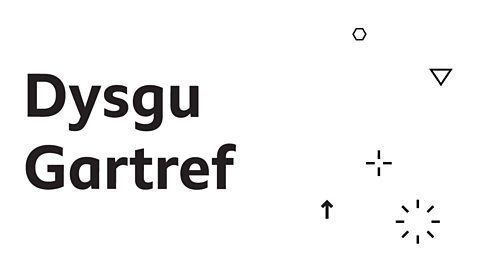
Ffocws dysgu
Dysga sut i ateb cwestiynau mwy cymhleth sy’n gysylltiedig â dy brofiadau dy hunain, storïau neu ddigwyddiadau.
Mae'r wers hon yn cynnwys:
- un fideo
- dau weithgaredd
Learning focus
Learn how to answer more complex questions relating to own experiences, stories or events.
This lesson includes:
- one video
- two activities
For an English version of this lesson, scroll below.

Atebion cadarnhaol a negyddol
Yn Saesneg, rwyt ti'n defnyddio un gair am ateb cadarnahol, sef Yes, ac un gair am ateb negyddol, sef No.
Ond yn Gymraeg, mae sawl ffordd i ateb yn gadarnhaol ac yn negyddol, ac mae'r atebion yn dibynnu ar y cwestiwn.
Edrycha ar yr enghreifftiau isod o gwestiynau ac atebion rwyt ti siŵr o fod yn gwybod yn barod:
| Cwestiwn | Ateb cadarnhaol | Ateb negyddol | |
|---|---|---|---|
| Wyt ti…? | Ydw | Nac ydw | |
| °ż±đ˛ő…? | Oes | Nac oes |
Mae hefyd atebion cadarnhaol a negyddol eraill yn Gymraeg. Gwylia'r fideo isod i ddysgu mwy.

Fideo
Mae athrawes Gymraeg yn trafod yr atebion cywir sydd eu hangen i gwestiynau sy'n:
- ddatganiad
- cyfeirio at ddigwyddiad yn y gorffennol
- dechrau gyda 'Ga i…?'
Nodiadau i rieni
Ar Ă´l gwylio'r fideo, bydd disgyblion yn gallu:
- adnabod ffurf negyddol a chadarnhaol i ateb y cwestiwn, ee Ie/Na, Do/Naddo, Cei/Na chei
- ateb cwestiynau yn gywir gan ddefnyddio ffurfiau cywir, ee Ie/Na, Do/Naddo, Cei/Na chei

Gweithgaredd 1
Ateba'r cwestiynau isod gan ddefnyddio’r ffurf gadarnhaol gywir.
- Est ti i'r dref ddoe?
- Ai Cymru enillodd y gĂŞm Dydd Sul?
- Ga i baned, plîs?
- Ga i fynd i’r tŷ bach?
- Ai gyda Dafydd aeth e i'r parti?
- Est ti ar dy wyliau llynedd?
Ar Ă´l gorffen, beth am ateb y cwestiynau eto gan ddefnyddio'r ffurf negyddol gywir?

Gweithgaredd 2
Wyt ti'n gallu meddwl am dy gwestiynau dy hun, ac ateb y cwestiynau hynny gan ddefnyddio'r ffurfiau cadarnhaol a negyddol gwahanol? Meddylia am enghraifft ar gyfer pob un ateb sydd wedi ei restru isod.
- Ydy/Nac ydy
- Oes/Nac oes
- Ie/Na
- Do/Naddo
- Cei/Na chei

Gweithgaredd 3
Gwna restr o gwestiynau allet ti ofyn i ffrind newydd i ddod i'w adnabod yn well. Cofia ofyn cwestiynau sy'n rhoi'r atebion canlynol i ti:
- Ydy/Nac ydy
- Oes/Nac oes
- Ie/Na
- Do/Naddo
Beth am greu ffeil o ffeithiau sy'n cynnwys gwybodaeth am dy ffrind newydd? Gallet ti wneud hyn ar Ă´l i ti holi cwestiynau a gwneud y gwaith ymchwil.

Positive and negative answers
In English, you use one word for a positive answer (yes) and one word for a negative answer (no).
But in Welsh there are several ways of using a positive and negative answer, and the answers depend on the question.
Look at the examples below of answers you're likely to know already:
| Question | Positive answer | Negative answer | |
|---|---|---|---|
| Wyt ti…? (Do you…?) | Ydw (Yes, I do) | Nac ydw (No, I don't) | |
| °ż±đ˛ő…? (Is there…?) | Oes (Yes, there is) | Nac oes (No, there isn't) |
There are also other positive and negative answers in Welsh. Watch the video below to learn more.

*Video *
A Welsh teacher discusses the correct answers needed for any questions that:
- are a statement
- refer to an event in the past
- start with 'Ga i…?' (May I have…?)
Notes for parents
After watching the video, pupils will be able to:
- identify a negative and positive form to answer the question, eg Ie/Na, Do/Naddo, Cei/Na chei (Yes/No)
- answer questions correctly using correct forms, eg Ie/Na, Do/Naddo, Cei/Na chei (Yes/No)

Activity 1
Answer the questions below using the correct positive form (yes).
- Est ti i'r dref ddoe? (Did you go to town yesterday?)
- Ai Cymru enillodd y gĂŞm Dydd Sul? (Was it Wales that won the game on Sunday?)
- Ga i baned, plîs? (May I have a cuppa, please?)
- Ga i fynd i’r tŷ bach? (May I go to the toilet?)
- Ai gyda Dafydd aeth e i'r parti? (Was it with Dafydd that he went to the party?)
- Est ti ar dy wyliau llynedd? (Did you go on holidays last year?)
When you have finished, how about answering the questions again using the correct negative form (no)?

Activity 2
Can you think of your own questions, and answer those questions using the different positive and negative forms? Think of an example for each answer listed below. All the answers below can be translated into English as 'Yes/No'.
- Ydy/Nac ydy
- Oes/Nac oes
- Ie/Na
- Do/Naddo
- Cei/Na chei

Activity 3
Make a list of questions you can ask a new friend to get to know them better. Remember to ask questions that will give you the following answers, which all mean 'Yes/No' in English:
- Ydy/Nac ydy
- Oes/Nac oes
- Ie/Na
- Do/Naddo
- Cei/Na chei
Why not make a fact file about your new friend? You can do this after you have asked questions and done research.

Hafan 91Čȱ¬ Bitesize
Gwyddoniaeth, Saesneg, Hanes a mwy - mae popeth yma i ti

Cynnwys y tymor hwn
Fideos, cwisiau a gweithgareddau i dy gefnogi yn ystod y tymor hwn

TGAU
Canllawiau dysgu i'r rhai ym mlwyddyn 10 ac 11
